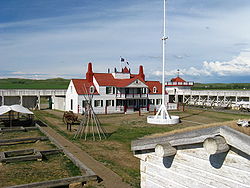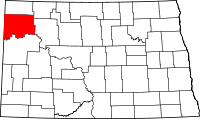|
Trails to the Past of North Dakota is excepting any donations of genealogy materials that you may have such as marriage announcements, news articles, old obituaries, births, (you do not need the birth certificate) just the information, and biographies. If you have any of these items please contact me Marie Miller the North Dakota State Administrator.
There have been two Williams counties in the history of North Dakota. The first, created in 1873, was located south of the Missouri River near where Dunn and Mercer counties are today. The second Williams County was established by the 1891 state legislature and consists of the contemporary Williams and Divide counties. The name comes from Erastus Appelman Williams, an early politician from Bismarck who served in both the territorial and state legislatures. The county government was first organized on December 8, 1891; Williston has always been the county seat.
Lake Sakakawea, a reservoir on the Missouri River, is situated on the southern boundary of the county. Little Muddy Creek is entirely within Williams County. The confluence of the Yellowstone River with the Missouri is west of Williston.
 The Fort Union Trading Post National Historic Site is located in Williams County along the Missouri River on the Montana border. Fort Union Trading Post National Historic Site is the site of a partially reconstructed trading post on the Missouri River and the North Dakota/Montana border twenty-five miles from Williston. It is one of the earliest declared National Historic Landmarks of the United States. The fort, perhaps first known as Fort Henry, was built in 1828 or 1829 by the Upper Missouri Outfit managed by Kenneth McKenzie and capitalized by John Jacob Astor's American Fur Company. The Fort Union Trading Post National Historic Site is located in Williams County along the Missouri River on the Montana border. Fort Union Trading Post National Historic Site is the site of a partially reconstructed trading post on the Missouri River and the North Dakota/Montana border twenty-five miles from Williston. It is one of the earliest declared National Historic Landmarks of the United States. The fort, perhaps first known as Fort Henry, was built in 1828 or 1829 by the Upper Missouri Outfit managed by Kenneth McKenzie and capitalized by John Jacob Astor's American Fur Company.
Fort Union Trading Post was the most important fur trading post on the upper Missouri until 1867. At this post, the Assiniboine, Crow, Cree, Ojibwe, Blackfoot, Hidatsa, and other tribes traded buffalo robes and furs for trade goods including items such as beads, clay pipes, guns, blankets, knives, cookware, cloth, and especially alcohol. Historic visitors to the fort included John James Audubon, George Catlin, Father Pierre DeSmet, Sitting Bull, Karl Bodmer, and Jim Bridger.It was declared a National Historic Landmark in 1961. Today, the reconstructed Fort Union memorializes a brief period in American history when two cultures found common ground and mutual benefit through commercial exchange and cultural acceptance.

Townships
|
|
|
|
Alamo
Athens
Barr Butte
Big Meadow
Big Stone
Blacktail
Blue Ridge
Bonetraill
Brooklyn
Buford
Bull Butte
Champion
Climax
Cow Creek
Dry Fork
|
Dublin
East Fork
Egypt
Ellisville
Equality
Farmvale
Golden Valley
Good Luck
Grenora
Hanks
Hardscrabble
Hazel
Hebron
Judson
Lindahl
|
Lund's Landing
Marshall
McGregor
Missouri Ridge
Mont
New Home
Oliver
Orthell
Pleasant Valley
Rainbow
Rock Island
Round Prairie
Sauk Valley
Scorio
South Meadow
|
Springbrook
Stony Creek
Strandahl
Tioga
Trenton
Truax
Twelve Mile
Tyrone
View
West Bank
Wheelock
Williston
Winner
Zahl
|
Adjacent Counties
Divide County (north)
Burke County (northeast)
Mountrail County (east)
McKenzie County (south)
Roosevelt County, Montana (southwest)
Sheridan County, Montana (west)
The information on Trails to
the Past © Copyright may be used in personal family history research, with source citation. The pages in entirety may not be duplicated for publication in any fashion without the permission of the owner. Commercial use of any material on this site is not permitted. Please respect the wishes of those who have contributed their time and efforts to make this free site possible.~Thank you!
|



